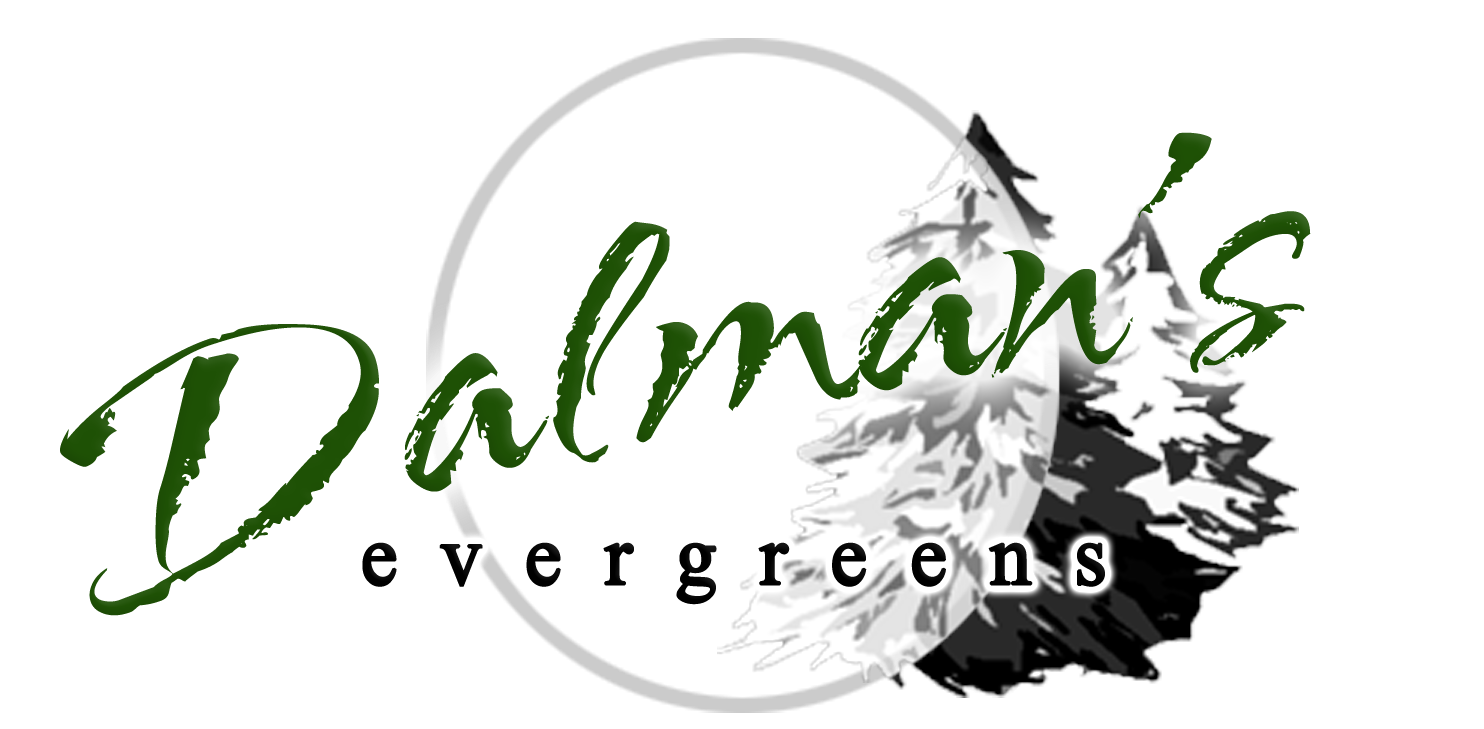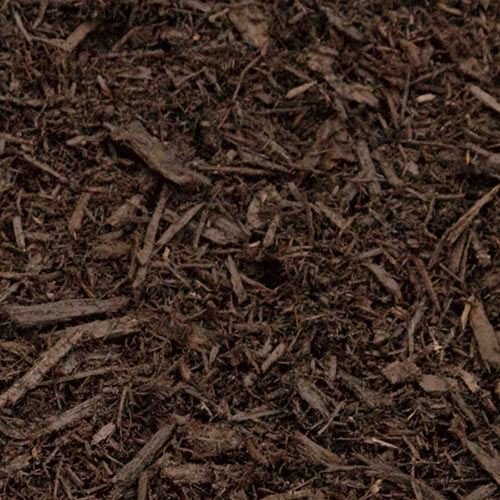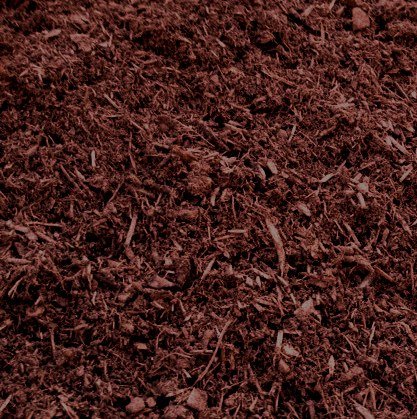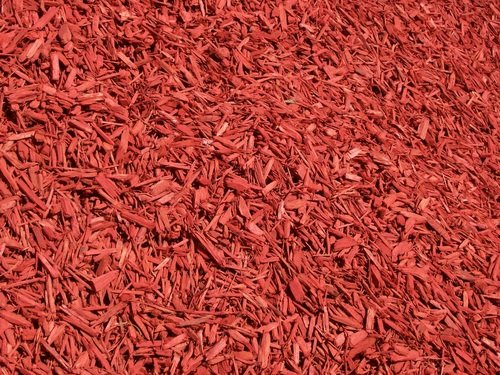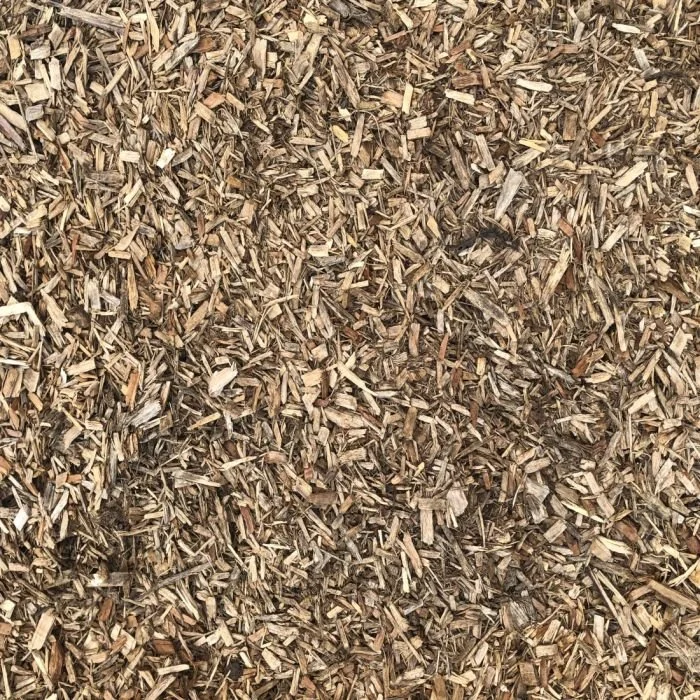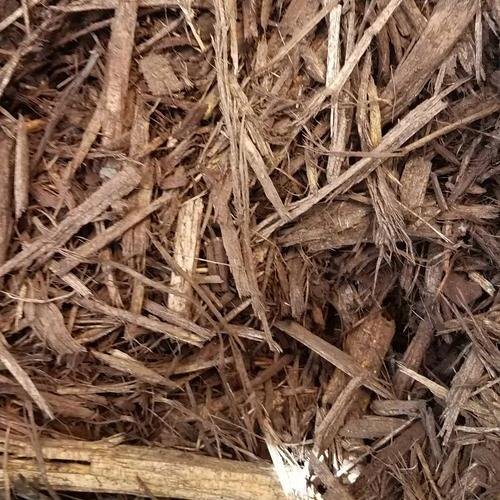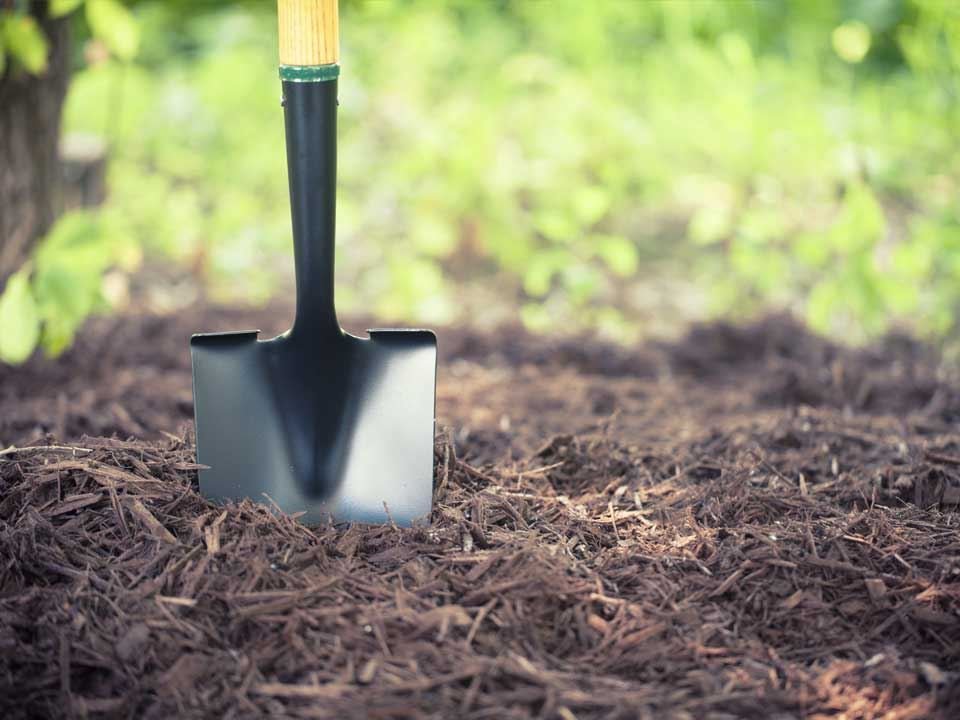
Aged Double Ground
-
Dalman's own Aged Mulch is proudly made onsite Evergreens each year in the spring by owner Matt Dalman.
Our customers have been calling us with extreme satisfaction regarding our blend of mulch. It's a medium brown color that will tan in the sun. We think this is our most popular mulch due to the quality to price ratio.
Dark Brown Double Ground
-
Dark Brown Double Ground is by far our most popular color-enhanced product due to its long-lasting dark brown color. It adds head turning curb appeal to any landscape.
Read more about our all-natural color enhancement here.
Auburn Double Ground
-
We began offering this product in 2016 and our customers loved it! This rich brown mulch offers a hint of red that really turns heads. Its double-ground and color enhanced for lasting color.
Learn more about our all-natural color enhancement here.
Black Double Ground
-
This is the darkest color we offer. It has a long-lasting natural look for your beds. It’s double-ground and color enhanced.
Read more about our all-natural color enhancement here.
Cherry Red Double Ground
-
This is the classic version of Cherry Red Mulch that really pops! It’s double-ground and color-enhanced for long lasting color.
Read more about our all-natural color enhancement here.
Playground
-
Playground Mulch is chipped and safe for playgrounds as it contains less dust.
Premium Bark Triple Ground Fines
-
Premium bark fines are a medium-dark brown color without color enhancement. This is a fine product that will keep it’s color as it’s made from the bark of the tree.
Econo Single Ground
-
This is a light brown single ground mulch that has not been through the aging process. It’s not recommended for garden beds as it hasn’t been through the aging process.
Read why the aging process is so important for plants here.
-
What Does Double Ground Mean?
Our mulch is ground two times through a 2" screen. This means you can expect your mulch pieces to be less than 2" wide on average, however, there is a potential for up to 1% of our mulch to make it's way through the screen lengthwise. This means you may find a few larger pieces in your pile even though the over all product remains consistent. Some find this beneficial as those pieces will not break down as quickly giving your mulched bed coverage for a longer period of time.
What Does Triple Ground Mean?
Triple Ground refers to a finer mulch product than Double Ground. It goes through a 1” screen. Like the Double Ground mulch, there is the potential for some pieces to make their way through the screen lengthwise, however, the overall product is consistent.
-
Fresh chipped mulch pulls nitrogen from the soil and can starve your plants of nitrogen which can weaken or kill plants and act as a detriment to future growth in that area. Aged mulch does not pull nitrogen from your soil allowing your plants to thrive.
Some plants found in fresh wood chips contain a biochemical (see allelopathy) that can affect or inhibit the growth, survival, and reproduction of other organisms. When your chips are allowed to age this biochemical is effectively diminished, therefore, aged mulch is better for your plants.
-
Our premium hardwood color-enhanced mulch provides a vivid and unique curb appeal to any home. It retains its bright colors longer than traditional mulch as it has higher UV-resistance.
The colorants used are safe for people, animals, the environment and are biodegradable. In fact, recent independent laboratory studies looked at color enhanced mulch very closely to determine its toxicity. It was found that in contrast, baking soda and table salt have higher levels of toxicity than color enhanced mulch.
We offer color enhanced mulch in the following colors: Cherry Red, Dark Brown, Black, and Auburn.
-
With the cost of delivery charges you don’t want to make an error on the number of yards needed. If you underestimate, you’ll be paying another delivery fee. If you over estimate you’ll be looking for extra places to spread it around your yard. Laying mulch too thick can obstruct water and air to the roots of your plants. Whether you’ve underestimated or overestimated, one this is sure, both time money have been lost.
Before placing your order find out your approximate square footage. I’m not saying you need to measure each bed to the inch, but if you have a general idea of your square footage you’ll be ahead of the game when ordering. A good rule of thumb is that 1 yard of mulch will cover approximately 108 sq’ at 3” deep. I usually picture this as just over a 10’x10’ area.
If you want to find more exact measurements, sketch your beds on a piece of paper breaking your beds into shapes. Find the area of each shape. If you need some help this link may be useful. http://www.calculator.net/area-calculator.html
Once you have the area in feet divide it by 108 to find out how many yards you need.
Note: One cubic yard contains 27 cubic feet of mulch or covers approximately 108 sq’ at 3” deep.
If you’ve traditionally purchased bags remember there are 13.5 of 2cu’ bags in 1 yard.
-
The list of benefits of mulching your garden is an extensive one. Here are 4 of the biggest reasons why you should mulch your beds.
1. Mulch insulates plant roots and steadies temperature changes. A layer of mulch will act as insulation during fluctuating temperatures. Bare soil will absorb heat more readily than mulch-covered soil. Although warm soil aids in plant growth, maintaining an even temperature is more beneficial. In times of cold weather, mulch will act as a protective barrier keeping the soil temperature from dropping too drastically.
2. Mulch affects moisture content of the soil. Moisture evaporates more easily from bare soil than from mulch-covered soil.
3. Mulch acts as erosion control. Bare soil washes away more easily if there is no barrier to keep it in place. A layer of mulch will prevent soil displacement.
4. Mulch adds nutrients to your soil. Mulch breaks down naturally adding nutrients to your soil for healthier plant life. TIP: Avoid using fresh wood chips as the early decomposition stages actually pull nutrients out of soil and are not as beneficial as a properly aged mulch.
-
Homeowners are always upset about weeds coming back. From hobbyist gardeners to professional landscapers, painstaking efforts have been taken to rid our lives of weeds. Although there is no way of permanently ridding your beds of weeds, there are ways to deter them. Here are some of the best (and worst) methods of keeping them at bay.
WOOD MULCH: As with any other form of mulching, results as a weed deterrent are similar. Wood mulch can help discourage weeds from taking a strong root, but it will not keep seeds from germinating that will eventually need to be removed. The benefits of mulching are seen more in moisture retention, erosion control insulation, and addition of nutrients to soil. Wood mulch, in particular, doesn’t decompose as quickly or move as easily as with other forms of mulching.
LEAF MULCH: Leaves can be great for your garden after being prepped properly (improper prep can result in drainage issues along with mold, fungus and other diseases). Some leaves can raise the acidity in your garden so you may want to test your soil before trying it. As far as a weed deterrent, results are similar to using wood mulch – they can still take root and eventually need to be removed.
GRASS CLIPPING MULCH: When properly prepped and applied grass clippings can be an excellent form of mulching, although results as a weed deterrent are comparable to that of wood chip mulching if not worse. If laid too thickly and not dried properly, grass clippings can be a smelly rotten mess in your garden promoting mold and disease. Because there are weeds in your lawn, there is a chance that seeds will end up in your garden bed. NOTE: Do not use grass clippings in your garden beds if you have applied chemicals in your lawn.
LANDSCAPE FABRIC: In theory, landscape fabric is supposed to keep weeds from being able to take root. In reality, seedlings are still able to sprout and if they are not pulled right away their roots go through the tiny holes in the fabric making them even more difficult to pull without displacement of the weed fabric and top dressing. Over time, the holes become clogged with dirt causing drainage issues. Mulch displacement is also an issue as it has nothing to adhere to. Mulch can shift and move leaving bare spots with nothing but fabric showing through.
NEWSPAPER: There are many out there who are happy with the results of using newspaper as a weed deterrent. Personally, I didn’t find that it deterred weeds any more than mulching alone, and was unhappy with the mess it made over time.
HERBICIDE: Although extremely effective using little effort, the lasting effect of the bad often outweighs the good when using harmful chemicals. These chemicals can have adverse effects on the health of people and their pets by remaining in the soil and running off into waterways long after they are applied.
NATURAL REMEDIES: Environmental awareness groups do their best to deter consumers from purchasing herbicides with harmful chemicals by promoting the use of Natural Herbicides. Usually, these products contain soaps, acetic acid, or botanically based oils. Usually these kill only the greens on a plant, not effecting the roots. This means that a particularly strong plant can recover from natural herbicide application. Overall effectiveness can be improved by using under the right weather conditions, treating the plant when it’s small, and repeating applications according to directions.
-
After spending time and money on creating the landscape you want, it can be frustrating to find molds and fungus in your mulched beds. Don’t worry, though. It’s perfectly normal to find them in your mulch, as they grow on decaying wood and most are actually beneficial to the decomposition process. You can find them most of the year starting in early spring to mid fall, and often emerge after a period of rainy weather.
Here’s a look at a few of the organisms you might find.
MUSHROOMS & TOADSTOOLS: Mushrooms may look strange but they’re beneficial to your beds. Their size, shape and life span vary quite a bit depending on the type. Nothing needs to be done to get rid of them unless you don't like the look. They are easily removed by lifting them out of the bed and moving the mulch around to allow the area to dry out.
SLIME MOLD: This one is more unsightly than your average mushroom, however, it is still beneficial. People often refer to it as “dog vomit fungus” and is actually not a mold or fungus at all. It starts out looking like a yellowy-orange slimy mass that can be over a foot across that will eventually turn brown with white and become powdery. Usually you’ll see this in spring, but sometimes also in summer in shady places. Slime mold is not harmful to humans or animals and can be left alone or removed. To get rid of the mass reduce water to that area as it likes moisture. You can break it up so it will dry out, or you can remove it altogether.
WHITE POWDERY STUFF IN THE MULCH: If you’re prepping your beds to have a fresh layer of mulch added and find that last year’s mulch is compacted and has white powdery stuff in it don’t worry! It’s just another harmless fungus that can be easily removed by breaking up the clumping area and allowing it to lay in the sun before adding fresh mulch.
ARTILLERY FUNGUS: Artillery Fungus is not from our area, in northern Illinois, but it may be able to hitch a ride in mulch that doesn’t originate locally. It has tiny orange-brown cups with one black seed in it, and can be a real nuisance. The spores are shot out toward bright surfaces and can stick to the sides of your house or car and can be difficult to remove without damaging the surface. If you find artillery fungus in your beds, try applying mushroom compost to the area. It contains microbes that can destroy nuisance fungi.
For more information on molds and fungus in your mulched beds visit these links:
http://extension.psu.edu/publications/ul201
http://plantclinic.tamu.edu/factsheets/slime-mold/
-
There’s no doubt that beautifying your lawn is an excellent way to create curb appeal, but with the cost and time involved you want the job done right the first time. During my years of working in the garden and landscape industry I’ve seen time and time again avoidable headache and frustration caused while homeowners are purchasing mulch. Here are a few tips to keep in mind:
1. Know your square footage. With the cost of delivery charges you don’t want to make an error on the number of yards needed. If you underestimate, you’ll be paying another delivery fee. If you over estimate you’ll be looking for extra places to spread it around your yard. Laying mulch too thick can obstruct water and air to the roots of your plants. Whether you’ve underestimated or overestimated, one this is sure, both time money have been lost.
Before placing your order find out your approximate square footage. I’m not saying you need to measure each bed to the inch, but if you have a general idea of your square footage you’ll be ahead of the game when ordering. A good rule of thumb is that 1 yard of mulch will cover approximately 108 sq’ at 3” deep. I usually picture this as just over a 10’x10’ area.
If you want to find more exact measurements, sketch your beds on a piece of paper breaking your beds into shapes. Find the area of each shape. If you need some help this link may be useful. http://www.calculator.net/area-calculator.html
Once you have the area in feet divide it by 108 to find out how many yards you need.
Note: One cubic yard contains 27 cubic feet of mulch or covers approximately 108 sq’ at 3” deep.
2. Compare apples to apples. Often times, your local mulch companies will have their own names for the types of mulch they carry in stock. This can trip you up as a consumer when trying to do a price comparison. For example, Company A may call a product Premium Dark Brown and charge $42 per yard, while Company B may call a product Dark Brown Premium and charge $37. Come to find out, Company A’s product is more expensive because it’s a dyed product, while Company B’s is a natural product. A customer who is comparison shopping could be fooled into thinking they’re comparing apples to apples because of the similar names only find out later they didn’t get the product they were looking for. Avoid this by making sure your garden center gives you a full description of each type of mulch they carry along with the price.
3. Visit the garden center to see samples. Being able to tell what color your mulch will actually be when it arrives is difficult if you’re only hearing a description over the phone or seeing a picture online. Stopping in to the garden center to see what types they have available along with the size of the chips is the best way to be sure you’re picking the product you want.
4. Most Expensive Isn’t Best. Many customers will ask me “What’s the best mulch?” The answer is that there is no best. It boils down to a matter of opinion. Some people prefer a natural looking product, some want nutrients added, and some want a dyed product that will keep its color longer. In each of these instances, one thing is for sure: the most expensive mulch is not necessarily the best. Often, you’ll find that a Cypress, Cedar or Bark are being sold at a higher price as a “Premium” product, however, the only reason for their hefty price tag is the long trip it takes to bring those products to your area.
5. Buy Local. Not only is it great for your local economy to purchase mulch that was produced locally, but it could be beneficial to your garden. Many garden centers have their mulch shipped in from out of the area. Even if you ask an employee, they probably don’t know the origin of their mulch. This can be a problem as a great deal of mulch that is shipped in from out of the area comes from construction debris sites and could contain unnatural materials or chemicals. If possible, purchasing your mulch directly from the producer is a great way to cut out the middle man and assure that you know what you’re putting in your garden.
-
Color enhanced mulch can be a great way to turn your neighbor’s heads. There are many misconceptions out there about dyed mulch so if you’re thinking about purchasing it here’s what you should know:
1. Is mulch dye safe for people, plants and animals? Most mulch colorant is completely safe. Usually red mulch colorant is made with Iron Oxide and black mulch colorant is Carbon Black. Both materials are safe for people, plants and animals in the landscape.
2. Is dyed mulch really made of old pallets? Dyed mulch is not necessarily made with pallets. It depends on the company who produced the mulch. Often, a pallet company will take the leftover pieces that can’t be used to make a pallet and grind it into mulch as a pallet byproduct. In this instance, the wood hasn’t been treated with chemicals and nails haven’t been driven in to the boards so it’s safe to be used as mulch.
If your mulch was produced by a tree company then pallet waste would not have been used. They, instead, would have used chips produced from their tree jobs. Both of these options produce all-natural mulch.
Both pallet byproducts and arborist chips that haven’t been aged are best for producing brighter shades of color enhanced mulch such as Dyed Red or Dyed Gold. Darker shades of mulch are produced best with aged chips as they are darker in color to begin with.
3. Is dyed mulch made with construction debris? If your mulch came from a reputable distributor the answer is absolutely not! Unfortunately, when large scale demolitions occur there’s a need to dispose of all wood-related products. The easiest and most cost-effective way to do this is to grind the debris and sell it. The only way to be able to pass it off as a natural product is by dying it. This can be dangerous for people, animals and plants as treated or painted wood contains harmful chemicals. Mulch produced by a pallet or tree company would not contain any type of construction debris.
4. How long does the color last in dyed mulch? A general rule of thumb would be that color enhanced mulch lasts for one season (spring through fall), however, some darker shades can still look nice starting out in the next season.
5. Is dyed mulch mold resistant? Some of the better colorants have an additive that increases the longevity of their color. This additive also makes it more difficult for mold and fungus to grow on mulch.
6. Will colorant dye wash off? High end mulch colorants are designed to adhere to the mulch and should not wash off. When applying mulch there will be some color left on your hands, so gloves are recommended. This color is due to the particles of mulch left behind. Once the mulch is in place and not disturbed the colorant will not wash away, however, it will fade over time.
The best way to avoid unnatural or unsafe dyed mulch is to purchase directly from the producer whenever possible. In doing this, you can rest assured that your mulch was produced without construction debris using high quality, safe colorant.
-
When purchasing mulch, I’ve often had customers ask which is better – bagged or bulk. There’s no right or wrong when it comes to choosing, it’s simply a matter of preference. Here are a couple of things to keep in mind when deciding.
1 cubic yard = 27 cu feet = 13.5 2 cu’ bags
Bagged - Bagged mulch is easier to move around once you get it to your yard.
Bulk - Bulk mulch is cheaper than bagged, and has the advantage of being dropped off in your driveway saving you trips to the store. It usually originates locally except bark, cedar and cypress.
Remember - Pay attention to the source your mulch is coming from. Less reputable sources, such as bagged mulch found in gas stations or lesser quality bulk mulch can contain construction debris, chemicals or problem fungi like Artillery Fungus. Local garden centers might not have a good idea of where their mulch originates so if they don’t seem sure about where their mulch comes from, look elsewhere.
